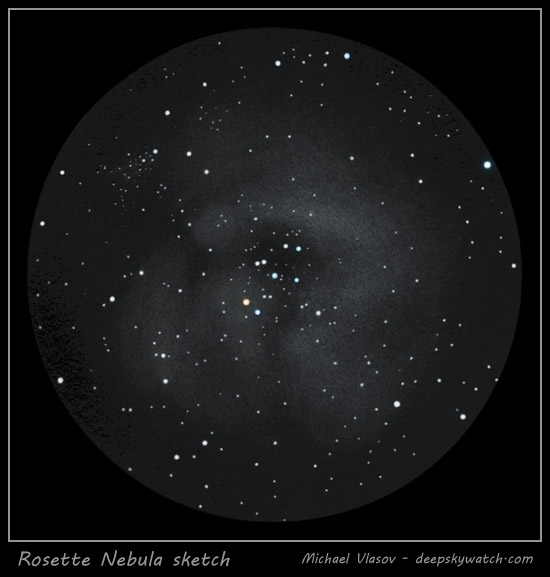Let's start with the APOD, even if it is large:
When Roses Aren't Red
Image Credit & Copyright: Tommy Lease (Denver Astronomical Society)
It's a handsome picture. The blue color in this mapped color image comes from doubly ionized oxygen, which represents a high level of excitation typically seen near very hot and energetic stars. In RGB images, the Rosette Nebula looks very red from ionized hydrogen alpha.
An even larger picture than the APOD - it's 5.9 MB - is so large that I hesitated to post it, but I'll do it anyway!
Isn't it glorious? Be sure to click to see the full size of it. Or, better yet, go to
this page to see it.
Anyway. You can see Orion's Belt, the three blue stars in a row, a little below center and a bit to the right. An elongated red patch is hanging from the leftmost star in Orion's Belt - that's where the Horsehead Nebula rears his tiny head - and below that, there are two pink blobs. The largest, brightest and pinkest of them is the Orion Nebula.
Well, this thread should be about the Rosette Nebula. And you can see the Rosette Nebula in the upper left corner.
Note the difference between the Rosette Nebula and the Orion Nebula. While the Orion Nebula is pink and bright white in the center, the Rosette Nebula is red, not pink, and it is not brighter in the center. In fact, the light from the very center of the Rosette Nebula comes mostly from the star cluster, not from the nebulosity. Actually the Rosette Nebula itself is so faint that it is hard to see it through a telescope.
Note! The Rosette Nebula is much larger than the Orion Nebula. The distance to the Rosette Nebula is 5,000 light-years, but the distance to the Orion Nebula is "only" some 1,500 light-years.
So the Rosette Nebula is much larger than the Orion Nebula. The Rosette is also much more attenuated, much fainter, and there is a hole at the center of it. Why? It is possible that the Rosette Nebula is definitely older than the Orion Nebula, so that the central stars have had much more time to eat away at the nebula and disperse it. But another explanation is that the cluster inside the Rosette Nebula, NGC 2264, is so much more energetic and powerful than the Trapezium cluster in Orion that it has dispersed its birth nebula so much more quickly.
After all, the Trapezium Cluster in Orion contains "only" one O-type star, Theta1 Orionis C, of spectral class O6V. But NGC 2244 contains at least five O-type stars, and the two hottest and brightest of them are spectral classes O4V and O5V.
To see what happens to the gas clouds that give birth to massive star clusters, consider the really massive Double Cluster of Perseus. Their age has been estimated at 12 million years. They undoubtedly contained several O-type stars when they were younger, but the O-type stars have either evolved into B-type supergiants or actually exploded as supernovas, although I haven't heard anything about supernova remnants in the Double Cluster.
So what happened to the mighty nebula that gave birth to this massive pair of star clusters? Well,
the latest APOD that featured the Double Cluster actually showed us some nebulosity on the outskirts of the clusters. No other portraits of these mighty star clusters have been able to do that, as far as I know!
The Double Cluster in Perseus. Note the nebulosity.
Credit: Mårten Frosth
And there is an animal parade of dust pillars walking a dust rim in the Rosette Nebula - the panther is famous:
Got to go now!
Ann
 When Roses Aren't Red
When Roses Aren't Red

